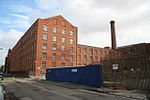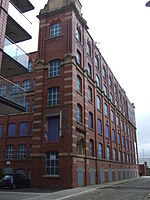Oxygen Towers
2021 establishments in EnglandApartment buildings in EnglandBuildings and structures in ManchesterGreater Manchester building and structure stubsResidential buildings completed in 2021 ... and 2 more
Residential buildings in ManchesterUse British English from March 2023

Oxygen Towers (also known as Oxygen) are a cluster of three individual but interlinked residential towers in Manchester, England. The 110 m (359 ft), 32-storey Tower 1 is the tallest element, with Towers 2 and 3 having 16 and 10 storeys respectively. The buildings were designed by 5plus Architects and Tower 1 is the 14th-tallest building in Greater Manchester as of 2023.
Excerpt from the Wikipedia article Oxygen Towers (License: CC BY-SA 3.0, Authors, Images).Oxygen Towers
Store Street, Manchester City Centre
Geographical coordinates (GPS) Address Nearby Places Show on map
Geographical coordinates (GPS)
| Latitude | Longitude |
|---|---|
| N 53.4803 ° | E -2.22471 ° |
Address
Store Street 50
M1 2FU Manchester, City Centre
England, United Kingdom
Open on Google Maps








